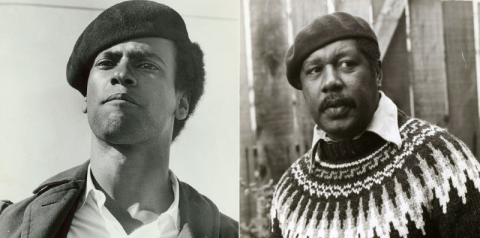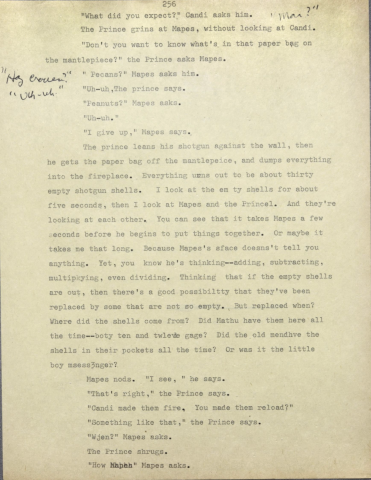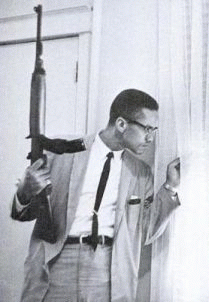Black Pride in Louisiana By David Squires
 |
|
Huey P. Newton (left) and Ernest J. Gaines (right) |
The iconography of Black Pride movements rarely if ever visualized the rural South. Black Power appeared in the streets of urban centers like Oakland, CA where Huey P. Newton and Bobby Seal founded the Black Panther Party. But Ernest J. Gaines, writing just across the San Francisco Bay, envisioned the implications of Black Power for a small community of Black folks in Louisiana who lived off the land as hunters, fishers, and farmers.
 |
|
The Black Panther Party |
A Gathering of Old Men shows Gaines grappling with his contemporary moment more explicitly than elsewhere in his oeuvre. Most of his fiction takes place in the Jim Crow era. A Gathering, set sometime in the late 1970s or early 1980s and first published in 1983, dramatizes life in South Louisiana in the wake of the Civil Rights Movement. It tells the story of a group of old men who come together to stage a reckoning. The old men of the title confront the law, each other, and the white community as they realize their own sense of manhood. Legal rights aside, they develop a sense of Black pride that lets them stand together, as evidenced by Mathu’s climatic comment, “I look up to you. Everyman in here. And this the proudest day of my life.”
While living in San Francisco, Gaines made trips back to Louisiana to stay in touch with the culture that informed his literary imagination. His life’s work was to preserve that culture, but in A Gathering we can see how San Francisco also influenced his writing. An early draft of the novel featured a character named Prince visiting from the Golden State to help organize the old men. The premise of the novel presents some clear echoes of the Black Power movement, from the strategy of assembling for self-protection to a willingness to use firearms. In 1964, Malcolm X famously declared the nonviolent tactics of the Civil Rights Movement outdated. In the founding objectives of the Organization of Afro American Unity, X advocated for freedom, justice, and equality “by any means necessary.” The Black Panther Party carried X’s philosophy forward, arguing for self-defense and armed revolution. “When the people move for liberation,” wrote Newton, “they must have the basic tool of liberation: the gun.” The gun became as much a symbol of Black Power as a tool. It signaled a willingness to defend the legal rights granted by the Constitution and the Civil Rights Act of 1964 in the face of on-going police brutality, social discrimination, and cultural marginalization.
 |
|
This is a facsimile of a page from an early draft of the A Gathering of Old Menin which the character "Prince" appears. It can be found in the Gaines Collection, FOlder 9-41, p. 256 |
Much as the image of armed Black Panthers startled many white Americans in the 1960s and 70s, the sight of old Black men with guns startles white characters in A Gathering. Lou Dimes notes his shock first when he stops in his tracks in front of “a wall of old black men with shotguns.” Later, Gil’s friend Sully compares their gathering to a Twilight Zone episode: “You would be driving through this little out-of-the-way town, and suddenly you would come upon a scene that you knew shouldn’t be there.” Sully’s comment suggests that such demonstrations of Black Power appeared out of place in the rural South. Yet, as historian Akinyele Omowale Umoja has documented, a Southern tradition of armed resistance against white supremacist terrorism played a key role in “protecting Black communities, their leaders, allies, and institutions,” including many of the organizations that fought for voting rights during the 1960s. Groups such as the Deacons for Defense and Justice , founded in Louisiana, practiced armed self-defense to deter KKK harassment and lynching, providing a historical precedent for the fictional old men in the novel who assemble to protect Mathu from Fix Boutan.
 |
|
Malcolm X with Gun |
Fix’s youngest son Gil registers white shock as well as the historical weight of the Black men’s self-defense strategy. In describing the old men at Mathu’s house for his father, Gil says, “I saw something over there, Papa—something you, I, none of us in this room has ever seen before. A bunch of old black men with shotguns, Papa.” His surprise echoes Lou Dimes and Sully, but Gil goes further to hint at the pride and determination motivating the old men. “Old men, Papa. Cataracts. Hardly any teeth. Arthritic. Old men. Old black men, Papa. Who have been hurt… Tired old men trying hard to hold up their heads.” Gil’s comment about the men having been hurt points to the historical fact of their oppression under Jim Crow laws and their exploitation as sharecroppers. In addition to their trauma, however, he also recognizes their gathering as an act of self-respect. As we learn from their monologues in Rufe’s chapter, each of the old men has experienced not just racial violence, oppression, and exploitation, but also a sense of degradation. Holding up their heads in this context means resolving the internal conflict driven by feelings of fear and guilt. As Rufe puts it, “we had all seen our brother, sister, mama, daddy insulted once and didn’t do a thing about it.” They did nothing as a strategy of survival because reacting would have made them targets of violence. As old men, without much left to lose, they decide to stand together to enact their own self-worth.
Gil represents a liberal voice among his community of unreconstructed Cajuns. Younger and better educated than his family members, he recognizes “the day of the vigilante” has passed. Gil also has a personal investment in institutional integration. He aspires to something other than sugarcane farming, something beyond Louisiana. As he explains to his father, he hopes to become a nationally recognized football player, which depends on cooperating with Cal, a Black teammate who is key to his success. This detail in the novel also has an historical precedent in LSU players Charles Alexander and Robert Dugas who shared All American status in 1978 . The representation of interracial athletic excellence in the novel makes clear how the perspective of a new generation depends on class aspirations and education. In that sense, Gil is both a product of his family background and a deviation from it.
Compared to Gil’s liberalism, the old men take a more aggressive position. An early draft of the novel expresses that aggression with the working title “The Revenge of Old Men .” Gaines clearly imagined their actions as seeking retribution for a history of oppression. To borrow a farm metaphor from Malcolm X, we might recognize their vengeance as chickens coming home to roost. The murder of Beau and subsequent manipulation of the law mirror the treatment the Black men describe being subjected to over the years. However, as the novel reaches its climax, the men move beyond revenge toward a Black collectivity that threatens the structure of plantation relations. The men exclude Candy, owner of Marshall Plantation, from their final talk. “Just the men with guns,” Clatoo tells her, and when she directs him off her property, he says he “ain’t taking no orders either” (173). The gesture to separatism signals a new solidarity among the Black men at the same time it exposes Candy as a fraught ally. Candy may feel more affinity for Mathu and the former sharecroppers in the quarters than her own relatives. Yet, she also maintains her social position as a landowning white woman. In the end, she impedes their process of self-actualization while contributing nothing to their shootout with the Luke Will’s gang. Their final act of self-defense brings their newfound pride to its logical conclusion, dramatizing the potential for Black revolution in rural Louisiana.
Gaines tends away from revolutionary sentiments for the most part. A Gathering gives readers a taste of what Black Power might have looked like in his fictional world, but the novel resolves its own revolutionary potential in a courtroom, law and order fully restored. Instead of the will to revolt against a racist society, we get a model for reconciling old antagonisms. Instead of social transformation, we get a model for remembering a proud people. In the process of gathering to protect Mathu, the old men carve out a brief moment in time and a small place in the world to voice their experiences. That insistence on recognizing the truth as they lived it goes some way toward memorializing their lives. In the novel, we see the cemetery as one site of memorialization at risk of destruction as industrialized agriculture threatens to plow it under. As Johnny Paul puts it, modernization threatens to destroy “all proof that we ever was” (92). His emphasis on the importance of the cemetery as a site of memory reminds us of the existential threats faced by the sharecropping community. A Gathering preserves their experience and their voices at the moment of their potential disappearance, the same way gravesites memorialize lives when they are lost. In that sense, the gathering this novel stages moves toward the shared horizon of Black Pride and cultural memory—a revolution in attitudes about what deserves recognition, representation, and preservation. The pride the men demonstrate together enables an act of self-preservation akin to the pride that motivated Gaines to write about life in the quarters. Although more even-handed than militant, his fiction displays a resolute commitment to the value of his people and the place they called home.
Works Cited
Arceneaux, Jordan. “Deacons for Defense Provided Protection When No One Else Would.” USA Today, 6 February 2016. https://www.usatoday.com/story/news/nation-now/2016/02/06/deacons-of-defense-robert-hicks/78955042/
Gaines, Ernest J. A Gathering of Old Men. New York: Penguin, 1983.
Newton, Huey P. “In Defense of Self Defense.” The Black Panther, 20 June 1967. Reprinted in “Essays from the Minister” available at https://archive.lib.msu.edu/DMC/AmRad/essaysministerdefense.pdf
Umoja, Akinyele Omowale. We Will Shoot Back: Armed Resistance in the Mississippi Freedom Movement. NYU Press, 2013.
X, Malcolm. “Speech at the Founding Rally of the Organization of Afro-American Unity.” 28 June 1964.
